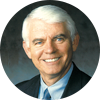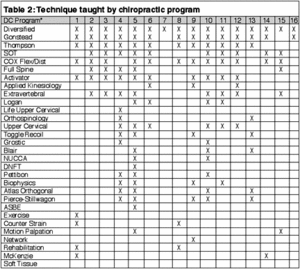"Sure, let me just check to see who is practicing near where you live." Escaping to his private office, Dr.
A quick review of the online Yahoo Yellow Pages helps Dr. Brown recognize that some of the doctors indicate practicing particular techniques, but most emphasize specialty care for auto accidents and workers' compensation injuries. Yet Mrs. Jones' care is unrelated to an accident.
"What am I to do?" laments Dr. Brown.
"A quick call will help me make a reliable referral. I'll just pick someone off the list and talk with him or her about his or her procedures." After getting past the receptionist and waiting for the doctor to come to the phone, Dr. Brown explains the patient's problem and asks Dr. Green how he would handle the case.
"This is a straight chiropractic practice and we only adjust the upper cervical spine," replies Dr. Green. "Furthermore, we would require our own set of upper cervical x-rays so we can conduct a specific analysis before rendering an adjustment. We cannot be concerned with Mrs. Jones' complaint in her hip; that is a medical diagnosis, and we don't provide care for such."
"Maybe Dr. White will be more helpful. If I can just find someone who will accept my records and follow the same conservative protocol, Mrs. Jones will be just fine with minimal care." This time, Dr. White answers the phone directly, since his receptionist is out to lunch.
"We run a very broad-scope practice in our office. Hip is no problem. In fact, we will do a full-spine x-ray to find the major subluxation that is causing the hip pain, give her a pre-sold treatment plan with a discount, add to that a six-month intense rehabilitation program, and start her on a prophylactic dietary program that will include a broad-scope vitamin, glandular supplements, distilled water fast, and our very own homeopathic remedy freshly prepared this morning by my wife."
"My third try should be the charm." Dr. Brown calls Dr. Black: "Mrs. Jones needs some follow-up care for an ailing hip problem that was aggravated during her vacation visit in our area. I am looking for someone who practices conservative care, with the ability to perform certain procedures for the pain she experiences."
Dr. Black responds, "Not a problem, Dr. Brown. We can take care of any problem that presents at our office. I have been in practice for 25 years and I have taken seminars and studied every technique utilized in the profession. I have certificates on my wall showing that I have mastered 15 different technique systems. If system one doesn't help Mrs. Jones after a few weeks of care, I will try system two. If system two fails, we can continue on this way through15 different systems. That should cover her care for at least the next year."
Dr. Brown returns to Mrs. Jones who has been patiently waiting. "Mrs. Jones, could you possibly delay your trip home for just one more week so I can complete the care you need to be fully functional again?"
This scenario is no fantasy. Mrs. Jones could have ended up with a doctor of chiropractic who failed to meet her expectations based on previous care, and thus become disillusioned with chiropractic. Any professional or service organization is faced with the same challenge. The more defined the standard of care and assurance of quality is, the less likely service delivery will tarnish the group image.
Society makes certain assumptions about professional and service organizations, especially those rendering health care. A certain trust and expectation is imposed upon those bearing the responsibility of helping to improve the health of others. I pose the following as social expectations of chiropractic.
Five Assumptions: Fact or Fiction
- All doctors of chiropractic are licensed to practice, thereby assuring the public of competency and the ability to practice safely.
Anyone practicing in areas where chiropractic is licensed or registered should be so noted by the appropriate governing agency. Obtaining such recognition may vary between different jurisdictions. At one time, there were 50 different state licensing exams in the United States. Today, the majority of states accept passage of part IV of the National Board of Chiropractic Examiners in lieu of their own exams. As part IV grows in acceptance, there will be a greater assurance of a minimum level of competency. Passage of part IV is accepted evidence that the candidate knows at least enough to employ safe practice procedures.
While there is good evidence to support this assumption, there is more to be considered. What is the difference in competency between those who pass with a marginal score and those who fail by a marginal score? What is the difference between one who passes with a marginal score and one who excels well beyond the pass mark? Once licensure is obtained, is competency maintained or enhanced by continuing education, or dulled by the absence of learning demands experienced in school? Should there not be a recurring demonstration of competency on a timely basis for all practitioners?
- All chiropractic programs are accredited by the Council on Chiropractic Education (CCE-U.S.) in the United States, so all curricula teach the same adjustive techniques equally well.
No. While the Standards of the CCE-U.S. outline criteria for performance to obtain accreditation, there is no prescribed curriculum demanding certain courses, or even a number of hours in technique training. The program must demonstrate through appropriate evaluation procedures that graduates are competent to perform adjustive techniques of their choosing.
In a recent survey conducted by the California Board of Chiropractic Examiners,1 technique courses offered at the various programs varied widely. Table 1 lists the technique types and what programs teach them in any area. Table 2 lists the chiropractic programs and the techniques indicated on the survey that are taught in their core curriculum (required or electives), what techniques are used in their clinics, and what techniques are taught in their postgraduate programs. No wonder Dr. Brown had difficulty finding a referral.
What is listed as being taught and what is actually presented in the classroom may vary between programs, courses in the same program, and instructors teaching the same technique in the same chiropractic program. A simple catalog listing is no measure of the breadth and depth of the instruction presented. Technique training external to the campus program taught by nonfaculty adds complexity by either teaching something different and often conflicting with campus instruction, or at least distracting the student from the teaching in the curriculum.
- All students who graduate are equally proficient in the utilization of adjustive techniques.
No. Proficiency is difficult to quantify, and in part is measured by the receiver, the patient. A partial measure of proficiency will be patient compliance, e.g., do they return for additional care when requested? This is not a full-proof indicator, and it is doubtful that one exists.
The administering of an adjustment, while filled with scientific descriptors, is an art form. As such, its value is based on perception as well as prescription. Some students are more diligent in their efforts to become proficient in technique training. There are programs that demand higher levels of expertise and longer hours in training, while students enter programs with previous experience in the use of their hands. Others simply feel more comfortable in developing psychomotor skills than others.
It's not only likely that student proficiency varies at the time of graduation, but proficiency of experienced practitioners also varies, even among zealots of a particular technique system.
- The position and/or motion of a vertebra is limited to three planes or six directions of movement (or combination thereof), hence all adjustive procedures, regardless of the system they may be a part of, follow the same biomechanical principles and therefore result in the same dynamic thrust.
This assumption takes a very deterministic approach to the art of adjusting. Is there substance to this assumption? From a strictly biomechanical perspective, the experts would answer in the affirmative while allowing for individual variation of motion based on combinations of the six directions and three planes. Thus, there is a fundamental basis upon which techniques are performed. Dr. Joseph Janse used to teach his students, "If you know your anatomy and biomechanics, you will develop your own technique."
On the other hand, the artist in all of us will say, "This is how I perform an adjustment and while it may be similar to others, it is distinctly right for me." If we were to train 10 graduating students in a particular technique to a very high level of proficiency, having them all work together so that they all performed the same thrust in the same way, I wonder how similar their adjusting performance would be five years hence?
- All technique systems are based on evidence of effectiveness that substantiate their validity.
The truthfulness of this assumption would be determined by what is defined as "evidence." Many techniques carry the name of their originators, the people who extolled to the world the virtues of their personal successes in practice doing some thing in a particular way, i.e., their art forms. Over time, good adjusting procedures supported by good presentations at seminars grew into major technique systems. These sported their own theoretical bases, which drove not only their adjusting procedures, but their diagnostic criteria and their outcome evaluations.
The presence of scientific evidence explaining the mechanisms of adjusting effectiveness or the clinical efficacy is woefully lacking in nearly all the techniques listed. Those supported by modest levels of scientific data are to be applauded, but far too much of what we teach and what we do is little more than folk art. Patients improve and miracles continue to happen, often irrespective of the technique employed. But why and how?
I close with a call to action. Will the leadership of this profession (in this case the educational leadership, ACC) set a course that will bring order to what we teach and what we do in practice that patients might more fully benefit from the service we provide? Is one technique more effective than another, more efficient, or more supportable?
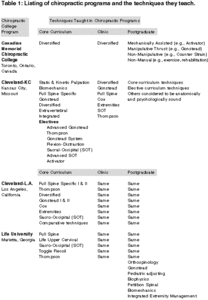
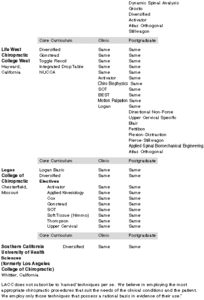
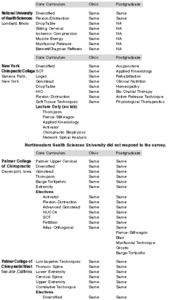
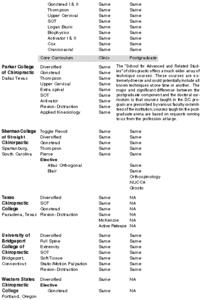
|
Reed Phillips,DC,PhD
President, Los Angeles College of Chiropractic
Reference:
- Smith, Kim. Report to the Joint Sunset Legislative Review Committee. Sept., 2001, Exhibit 6B.
- DC Programs
- Canadian Memorial Chiropractic College
- Cleveland College of Chiropractic-K.C.
- Cleveland College of Chiropractic-L.A.
- Life University
- Life Chiropractic College-West
- Logan College of Chiropractic
- Los Angeles College of Chiropractic
- National College of Chiropractic
- New York College of Chiropractic
- Palmer College of Chiropractic
- Palmer College of Chiropractic-West
- Parker College of Chiropractic
- Sherman College of Chiropractic
- Texas College of Chiropractic
- University of Bridgeport-College of Chiropractic
- Western States College of Chiropractic
Click here for previous articles by Reed Phillips, DC, PhD.
